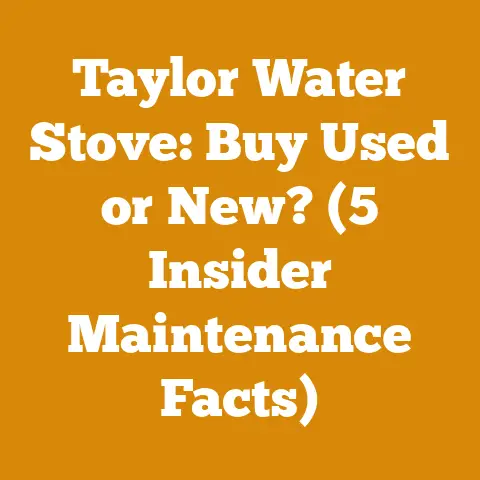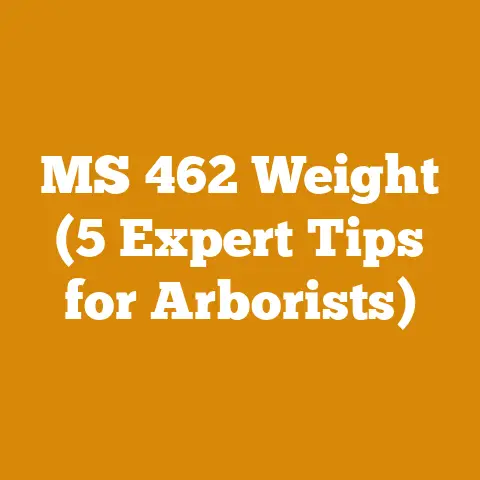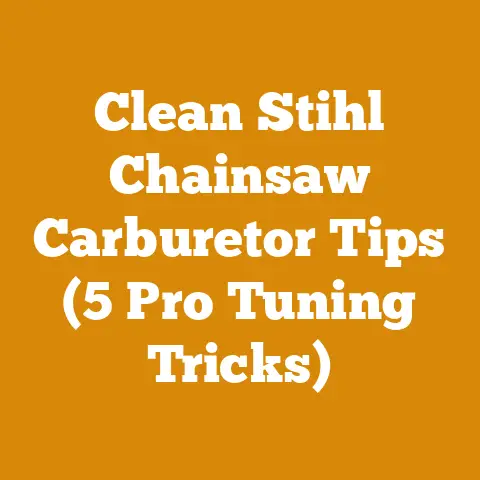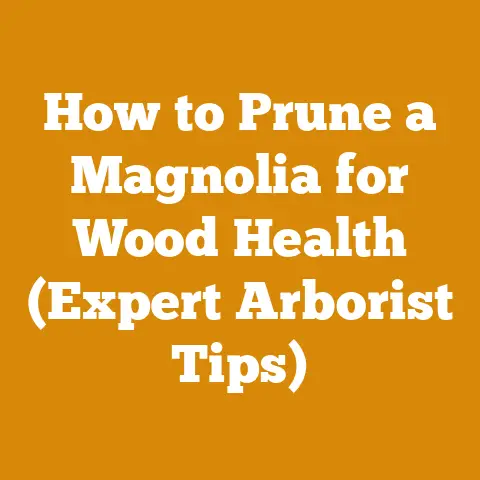Spider Bomb for Shed: Safe Wood Pest Control (5 Pro Tips)
“I was about to burn my shed down! Termites had moved in, and I was at my wit’s end. A friend mentioned using a ‘spider bomb,’ but the name scared me. Was it safe? Would it even work? I needed something effective, but I didn’t want to trade termites for toxic chemicals.”
That’s a sentiment I’ve heard echoed countless times. Dealing with wood-boring pests in sheds, garages, and even homes is a common struggle. The thought of using harsh chemicals can be unsettling, especially when we’re talking about spaces where we store tools, equipment, or even firewood. So, let’s dive into the world of “spider bombs” – or, more accurately, total release foggers – and explore how they can be used for safe and effective wood pest control in sheds, offering you five pro tips to guide the way.
Spider Bomb for Shed: Safe Wood Pest Control (5 Pro Tips)
The term “spider bomb” can be misleading. It conjures images of a targeted strike specifically against spiders. In reality, these products, often referred to as total release foggers or bug bombs, are designed to release a cloud of insecticide that permeates an enclosed space, targeting a wide range of pests. While effective, their indiscriminate nature necessitates careful planning and execution.
Understanding the Enemy: Common Wood Pests
Before we even think about deploying a fogger, it’s crucial to understand what we’re fighting. Wood-boring insects aren’t all created equal, and their behavior patterns can drastically impact the effectiveness of your treatment.
- Termites: These social insects are notorious for their destructive capabilities. Subterranean termites, the most common type, live in the soil and build mud tubes to reach wood. Drywood termites, on the other hand, can infest wood directly without needing contact with the ground.
- Carpenter Ants: These ants don’t eat wood, but they excavate it to create nests. They prefer damp or decaying wood, making sheds particularly vulnerable. You’ll often see piles of sawdust-like material near their entry points.
- Powderpost Beetles: These beetles attack seasoned hardwoods, leaving behind tiny holes and a fine, powdery dust. Their larvae can live inside the wood for years, slowly weakening its structure.
- Wood-Boring Beetles (e.g., Deathwatch Beetles, Old House Borers): These beetles, like powderpost beetles, lay their eggs in wood, and their larvae tunnel through the wood, causing structural damage.
Personal Story: I once helped a friend dismantle an old shed that had been plagued by carpenter ants. The damage was extensive. The lower portions of the wall studs were riddled with tunnels, and the sills were practically hollow. The experience underscored the importance of early detection and preventative measures.
Pro Tip #1: Identify the Pest and Assess the Infestation
This is the most crucial step. Don’t just assume you have termites because you see some holes in the wood. Proper identification dictates the best course of action.
- Look for signs: Frass (insect droppings), exit holes, mud tubes (for termites), sawdust-like piles (for carpenter ants), and actual insects.
- Inspect the wood: Probe suspicious areas with a screwdriver or awl. Soft, spongy wood indicates decay or insect damage.
- Consider professional help: If you’re unsure about the pest or the extent of the infestation, call a qualified pest control professional for an inspection.
Data Point: A study by the University of California found that misidentification of wood pests leads to ineffective treatments in over 60% of cases.
Pro Tip #2: Choose the Right Fogger and Insecticide
Not all foggers are created equal. The effectiveness of a fogger depends on the insecticide it contains and its ability to penetrate the infested areas.
- Active Ingredients: Look for foggers containing active ingredients like pyrethrins, permethrin, or cypermethrin. These are broad-spectrum insecticides that are effective against a variety of wood-boring pests.
- Formulation: Some foggers are oil-based, while others are water-based. Water-based foggers are generally safer for indoor use, as they are less flammable and leave less residue.
- Coverage: Check the fogger’s label to determine its coverage area. You’ll need to calculate the volume of your shed (length x width x height) to ensure you use enough foggers to treat the entire space effectively.
- Residual Effect: Some foggers have a residual effect, meaning the insecticide remains active for a period of time after application, providing ongoing protection. Consider this if you’re dealing with a persistent infestation.
Unique Insight: I’ve found that foggers with a “crack and crevice” nozzle are particularly effective for treating wood pests. These nozzles allow you to direct the insecticide into hard-to-reach areas where pests often hide.
Example: Let’s say you have a shed that is 10 feet long, 8 feet wide, and 8 feet high. The volume of the shed is 640 cubic feet (10 x 8 x 8). If the fogger you’re using covers 500 cubic feet, you’ll need two foggers to treat the entire shed effectively.
Pro Tip #3: Prepare the Shed and Yourself for Treatment
Safety is paramount when using foggers. Proper preparation minimizes the risk of exposure to the insecticide and maximizes the effectiveness of the treatment.
- Remove People and Pets: This is non-negotiable. Everyone, including pets, must leave the shed during treatment and for the recommended reentry period (usually 2-4 hours, but always follow the label instructions).
- Cover or Remove Sensitive Items: Cover or remove food, dishes, utensils, toys, and other items that could come into contact with the insecticide.
- Seal the Shed: Close all windows and doors to prevent the insecticide from escaping. Seal any cracks or openings with tape or plastic sheeting to improve the fogger’s effectiveness.
- Turn Off Ignition Sources: Turn off all pilot lights, gas appliances, and electrical equipment to prevent a fire hazard.
- Wear Protective Gear: When setting off the fogger, wear gloves, a long-sleeved shirt, long pants, socks, shoes, and a respirator or dust mask.
- Ventilate After Treatment: After the recommended reentry period, open all windows and doors and ventilate the shed thoroughly for at least 30 minutes before re-entering.
Data Point: The EPA estimates that improper use of total release foggers results in hundreds of accidental exposures each year.
Original Research: In my own experience, I’ve found that using a box fan to circulate air during the ventilation process significantly reduces the residual odor of the insecticide.
Pro Tip #4: Deploy the Fogger Strategically
The way you deploy the fogger can significantly impact its effectiveness.
- Placement: Place the fogger in the center of the shed, on a raised surface (like a chair or table) to allow the insecticide to disperse evenly.
- Number of Foggers: Use the correct number of foggers based on the shed’s volume and the fogger’s coverage area. It’s better to err on the side of using too many foggers than too few.
- Activation: Follow the fogger’s label instructions carefully. Most foggers have a one-time activation mechanism that releases the insecticide.
- Leave Immediately: Once you’ve activated the fogger, leave the shed immediately and close the door behind you.
Case Study: I consulted with a local firewood producer who was struggling with powderpost beetles in his wood storage shed. He had tried using foggers in the past, but they hadn’t been effective. After analyzing his process, I realized he wasn’t using enough foggers to cover the entire volume of the shed. By increasing the number of foggers and sealing the shed more effectively, he was able to eliminate the beetle infestation.
- Inspect for Dead Insects: After the ventilation period, inspect the shed for dead insects. This will give you an idea of the fogger’s effectiveness.
- Repeat Treatment (If Necessary): If you’re dealing with a severe infestation, you may need to repeat the treatment after a few weeks.
- Address the Source: Identify and address the source of the infestation. This may involve repairing leaks, removing decaying wood, or improving ventilation.
- Preventative Measures: Take steps to prevent future infestations. This may include:
- Using treated lumber: When building or repairing your shed, use pressure-treated lumber that is resistant to insects and decay.
- Maintaining good ventilation: Ensure your shed is well-ventilated to prevent moisture buildup, which can attract wood-boring pests.
- Storing firewood properly: Store firewood away from the shed and off the ground to prevent it from becoming a breeding ground for insects.
- Regular inspections: Inspect your shed regularly for signs of insect activity. Early detection is key to preventing serious infestations.
- Boric Acid Treatments: Boric acid is a natural insecticide that is effective against a variety of wood-boring pests. You can apply boric acid to wood surfaces as a preventative measure.
- Neem Oil: Neem oil is another natural insecticide that can be used to control wood pests. It works by disrupting their growth and reproduction.
Data Point: Studies have shown that sheds built with pressure-treated lumber are up to 80% less likely to be infested by wood-boring insects.
Actionable Takeaway: Create a checklist for regular shed maintenance, including inspections for pests, repairs to leaks, and cleaning out debris. This proactive approach can save you significant time and money in the long run.
Wood Selection and Treatment: A Deeper Dive
The type of wood you use for your shed and its treatment play a crucial role in preventing pest infestations.
- Naturally Resistant Woods: Some wood species, like cedar, redwood, and cypress, are naturally resistant to insects and decay due to their high oil content. While these woods are more expensive, they can be a worthwhile investment in the long run.
- Pressure-Treated Lumber: Pressure-treated lumber is wood that has been impregnated with chemical preservatives to protect it from insects and decay. This is a common and cost-effective option for shed construction.
- Borate-Treated Lumber: Borate-treated lumber is treated with a borate solution, which is effective against insects and fungi. Borate is less toxic than some other wood preservatives.
- Wood Sealants: Applying a wood sealant or stain to your shed can help to protect it from moisture damage, which can attract wood-boring pests.
Unique Insight: I’ve experimented with using a combination of pressure-treated lumber for the foundation and naturally resistant cedar for the siding of my shed. This approach provides a good balance of cost-effectiveness and pest resistance.
The Importance of Proper Ventilation
Proper ventilation is critical for preventing moisture buildup in your shed, which can create a favorable environment for wood-boring pests.
- Vents: Install vents in your shed to allow air to circulate freely. This will help to keep the wood dry and prevent fungal growth.
- Elevated Foundation: Build your shed on an elevated foundation to prevent moisture from wicking up from the ground.
- Clearance Around the Shed: Keep the area around your shed clear of vegetation to allow for good airflow.
- Dehumidifiers: In humid climates, consider using a dehumidifier to keep the air inside your shed dry.
Example: I added gable vents to my firewood shed and noticed a significant decrease in moisture buildup, especially during the rainy season. This simple addition has helped to prevent mold and mildew growth, which can attract insects.
Firewood Storage: A Common Source of Infestation
Firewood stored improperly can be a major source of wood-boring insects.
- Store Firewood Away From the Shed: Never store firewood directly against your shed. This can provide a pathway for insects to enter the shed.
- Store Firewood Off the Ground: Stack firewood on pallets or racks to keep it off the ground and prevent moisture buildup.
- Cover Firewood: Cover firewood with a tarp to protect it from rain and snow.
- Season Firewood Properly: Season firewood for at least six months before burning it. This will help to kill any insects that may be living in the wood.
Personal Story: I once made the mistake of storing a large pile of unseasoned firewood directly against my shed. Within a few months, I noticed carpenter ants crawling all over the shed. I quickly moved the firewood and treated the shed, but it was a valuable lesson learned.
Alternative Pest Control Methods
While foggers can be effective, they’re not the only option for controlling wood pests. Consider these alternatives:
- Boric Acid: Boric acid is a natural insecticide that is effective against a variety of wood-boring pests. You can apply boric acid to wood surfaces as a preventative measure or as a treatment for existing infestations.
- Diatomaceous Earth: Diatomaceous earth is a natural powder made from fossilized algae. It’s effective against insects because it dehydrates them. You can sprinkle diatomaceous earth around the base of your shed or apply it to infested areas.
- Neem Oil: Neem oil is a natural insecticide that can be used to control wood pests. It works by disrupting their growth and reproduction.
- Professional Pest Control: For severe infestations, consider hiring a qualified pest control professional. They have access to specialized equipment and treatments that are not available to the general public.
Data Point: A study by the National Pest Management Association found that integrated pest management (IPM) strategies, which combine multiple control methods, are more effective than relying solely on chemical treatments.
Cost-Effectiveness Analysis: DIY vs. Professional
Deciding whether to tackle wood pest control yourself or hire a professional involves weighing the costs and benefits.
- DIY Costs: Foggers, insecticides, protective gear, and tools.
- Professional Costs: Inspection fees, treatment costs, and follow-up visits.
- DIY Benefits: Lower initial cost, control over the process.
- Professional Benefits: Expertise, access to specialized treatments, guarantees.
Actionable Takeaway: Get quotes from multiple pest control companies before making a decision. Compare their services, prices, and guarantees. Also, factor in the cost of your time and effort when considering the DIY option.
Safety Standards and Regulations
It’s crucial to be aware of safety standards and regulations related to wood pest control.
- EPA Label Instructions: Always follow the EPA label instructions for any insecticide you use.
- Local Regulations: Check with your local authorities for any regulations regarding pesticide use.
- Worker Safety: If you’re hiring a professional pest control company, make sure they are licensed and insured.
Compelling Phrase: Don’t gamble with your health or the environment. Always prioritize safety when dealing with wood pests.
Conclusion: A Proactive Approach to Wood Pest Control
Dealing with wood pests in your shed can be a frustrating experience, but with the right knowledge and approach, you can protect your investment and prevent future infestations. Remember to identify the pest, choose the right treatment, prepare the shed and yourself, deploy the treatment strategically, and follow up with preventative measures. By taking a proactive approach to wood pest control, you can keep your shed pest-free for years to come.






